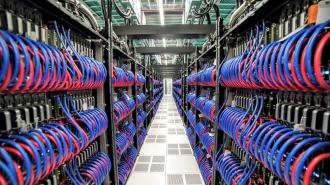The US’s Frontier system is now the fastest supercomputer in the world. It’s also the first exascale computer, meaning it can process more than a quintillion calculations per second — an ability that could lead to breakthroughs in medicine, astronomy, and more.
Why it matters: Supercomputers aren’t a fundamentally different kind of machine, like quantum computers — they work in the same basic way as your laptop, but with much more powerful hardware. This makes them invaluable tools for data-intensive, computation-heavy research.
“It took us a day or two [with the supercomputer] whereas it would have taken months on a normal computer.”
Jeremy Smith
When the pandemic first started, for example, researchers used Summit — the world’s fastest supercomputer at the time — to simulate how different compounds would attach to the coronavirus’ spike protein and potentially prevent infection.
“Summit was needed to rapidly get the simulation results we needed,” said researcher Jeremy Smith in March 2020. “It took us a day or two whereas it would have taken months on a normal computer.”
Other scientists use supercomputers to analyze genomes, map the human brain, simulate the formation of stars, and more.
The rankings: Twice a year since 1993, the TOP500 project has released a list of the 500 most powerful supercomputers in the world. To compile this list, it measures each system’s performance in FLOPS (“floating-point operations per second”).
A floating-point operation is a simple math problem (like adding two numbers). A person can typically perform at a rate of 1 FLOPS, meaning it takes us about one second to find the answer to one problem. Your PC might operate at about 150 gigaFLOPS, or 150 billion FLOPS.
In 2008, a supercomputer crossed the petaFLOPS threshold (one quadrillion FLOPS) for the first time, and since then, the goal has been an exaFLOPS system, capable of calculating at least one quintillion FLOPS (that’s a lot of zeroes: 1,000,000,000,000,000,000).
“Frontier is ushering in a new era of exascale computing to solve the world’s biggest scientific challenges.”
Thomas Zacharia
The fastest supercomputer: Frontier — a supercomputer at the Department of Energy’s Oak Ridge National Laboratory (ORNL) — has taken the top spot on the latest TOP500 list, and its score of 1.102 exaFLOPS on a benchmark test makes it the world’s first exascale computer.
According to ORNL, creating a computer with that kind of power required a team of more than 100 people and millions of components. The system occupies a space of more than 4,000 square feet and includes 90 miles of cable and 74 cabinets, each weighing 8,000 pounds.
Frontier is already more than twice as powerful as the second fastest supercomputer on the TOP500 list — Japan’s Fugaku, which had a score of 442 petaFLOPS — and according to ORNL, its theoretical peak performance is almost twice as fast, a full 2 exaFLOPS.
“Frontier is ushering in a new era of exascale computing to solve the world’s biggest scientific challenges,” ORNL Director Thomas Zacharia said. “This milestone offers just a preview of Frontier’s unmatched capability as a tool for scientific discovery.”
The caveat: Frontier might be the world’s fastest supercomputer and the first to cross the exascale threshold according to the TOP500 list, but China is suspected of having two exascale systems — it just hasn’t submitted test results to the TOP500 team.
“There are rumors China has something,” Jack Dongarra, one of the project’s leaders, told the New York Times. “There is nothing official.”
Looking ahead: ORNL plans to continue testing and validating Frontier before granting scientists early access to it later in 2022. The system should then be fully operational by January 1, 2023.
“Scientists and engineers from around the world will put these extraordinary computing speeds to work to solve some of the most challenging questions of our era,” said Jeff Nichols, ORNL Associate Lab Director for computing and computational sciences.
We’d love to hear from you! If you have a comment about this article or if you have a tip for a future Freethink story, please email us at [email protected].





